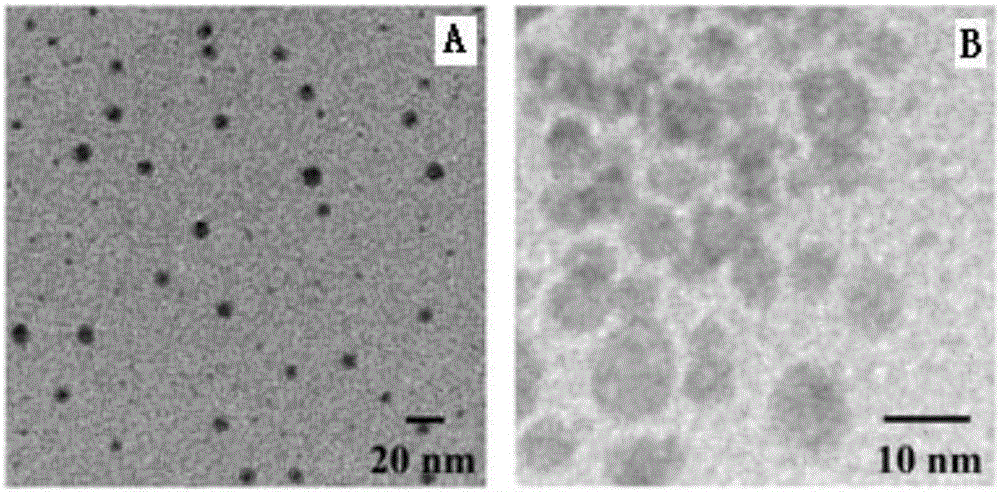Polyethylene glycol vitamin E succinate modified tigecycline loading silver nanoparticles as well as preparation and application
A technology of polyethylene glycol and succinate, which is applied in the direction of active ingredients of tetracycline, medical preparations with non-active ingredients, and medical preparations containing active ingredients, etc., can solve problems such as the prevalence of Acinetobacter, reduce toxicity, The effect of reducing the minimum inhibitory concentration and improving the antibacterial effect
- Summary
- Abstract
- Description
- Claims
- Application Information
AI Technical Summary
Problems solved by technology
Method used
Image
Examples
Embodiment 1
[0020] Example 1 Preparation of Tigecycline Silver Nanoparticles Modified with Polyethylene Glycol Vitamin E Succinate
[0021] Polyethylene glycol vitamin E succinate modified tigecycline silver nanoparticles were synthesized in two steps. The first step was to obtain polyethylene glycol vitamin E succinate modified silver nanoparticles. Take 15.6mL deionized water and set In a 30mL vial, placed in an ice-water bath ultrasonic pulverizer, first add 0.9mL silver nitrate aqueous solution (10mM), then add 120μL polyethylene glycol vitamin E succinate aqueous solution (40mM, polyethylene glycol chain polymerization degree n =23) Ultrasonic mixing, then adding sodium hydroxide aqueous solution, the reaction solution quickly becomes pale yellow, and the pH value of the solution rises to about 12, at which point silver oxide nanocrystals are formed. Quickly add freshly prepared 1.08mL sodium borohydride solution (10mM) to the obtained silver oxide nanocrystal solution, the solution ...
Embodiment 2
[0032] Example 2 Preparation of Tigecycline Silver Nanoparticles Modified with Polyethylene Glycol Vitamin E Succinate
[0033] Polyethylene glycol vitamin E succinate modified tigecycline silver nanoparticles were synthesized in two steps. The first step was to obtain polyethylene glycol vitamin E succinate modified silver nanoparticles. Take 15.6mL deionized water and set In a 30mL vial, placed in an ice-water bath ultrasonic pulverizer, first add 0.9mL silver nitrate aqueous solution (10mM), then add 120μL polyethylene glycol vitamin E succinate aqueous solution (40mM, polyethylene glycol chain polymerization degree ( n)=230) ultrasonic mixing, and then adding sodium hydroxide aqueous solution, the reaction solution quickly becomes light yellow, the pH value of the solution rises to about 12, and silver oxide nanocrystals are formed at this time. Quickly add freshly prepared 1.08mL sodium borohydride solution (10mM) to the obtained silver oxide nanocrystal solution, the sol...
Embodiment 3
[0044] Example 3 Preparation of Tigecycline Silver Nanoparticles Modified with Polyethylene Glycol Vitamin E Succinate
[0045] Polyethylene glycol vitamin E succinate modified tigecycline silver nanoparticles were synthesized in two steps. The first step was to obtain polyethylene glycol vitamin E succinate modified silver nanoparticles. Take 15.6mL deionized water and set In a 30mL vial, placed in an ice-water bath ultrasonic pulverizer, first add 0.9mL silver nitrate aqueous solution (10mM), then add 120μL polyethylene glycol vitamin E succinate aqueous solution (40mM, polyethylene glycol chain polymerization degree n =23) Ultrasonic mixing, then adding sodium hydroxide aqueous solution, the reaction solution quickly becomes pale yellow, and the pH value of the solution rises to about 12, at which point silver oxide nanocrystals are formed. Quickly add 1.08 mL of freshly prepared sodium borohydride solution (10 mM) to the obtained silver oxide nanocrystal solution, continue...
PUM
| Property | Measurement | Unit |
|---|---|---|
| Particle size | aaaaa | aaaaa |
Abstract
Description
Claims
Application Information
 Login to View More
Login to View More - R&D
- Intellectual Property
- Life Sciences
- Materials
- Tech Scout
- Unparalleled Data Quality
- Higher Quality Content
- 60% Fewer Hallucinations
Browse by: Latest US Patents, China's latest patents, Technical Efficacy Thesaurus, Application Domain, Technology Topic, Popular Technical Reports.
© 2025 PatSnap. All rights reserved.Legal|Privacy policy|Modern Slavery Act Transparency Statement|Sitemap|About US| Contact US: help@patsnap.com



